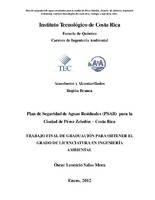Mostrar el registro sencillo del ítem
Plan de seguridad de aguas residuales para la ciudad de Pérez Zeledón-Costa Rica.
| dc.contributor.advisor | Pino-Gómez, Macario | es |
| dc.contributor.author | Salas-Mora, Óscar Leonicio | |
| dc.date.accessioned | 2015-08-31T22:31:16Z | |
| dc.date.available | 2015-08-31T22:31:16Z | |
| dc.date.issued | 2012 | |
| dc.identifier.uri | https://hdl.handle.net/2238/6251 | |
| dc.description | Proyecto de Graduación (Licenciatura en Ingeniería Ambiental). Instituto Tecnológico de Costa Rica. Escuela de Química, 2012. | es |
| dc.description.abstract | Acueductos y Alcantarillados (AyA) is the institution responsible for collecting, transport and give treatment to the waste waters in the city of Perez Zeledon. They possess a system based upon oxidation treatment lagoons that has more than 35 years of being in functioning, which was design for a population of 3000 inhabitants and an organic load of 150 Kg DBO/day. This system did not consider the rapid growth that has occurred in the last year in the city of Perez Zeledon and now the system should be treating the wastewater of 12000 inhabitants with an organic load of 460 Kg DBO/day. Added to this the system's weaknesses in the design and operation of the oxidation lagoons, among which may include: short circuit, lack of control accessories, operation and control issues among others. To evaluate the pickup-conduction of the system and treatment of the wastewaters a safety plan for wastewaters was design to have greater control over the generation, recollection, transport and wastewater treatment. This plan aims to provide a proposal and recommendations for the structuring of measures to control risks that could affect the quality of the residual water. From this plan were visualized the most representative risk and proposed the respective controls. The scope of this plan, is the evaluation to establish preventive actions and risk control in the system of residual waters integrating the generating entities and the population, together with AyA, and an ordering in the processes through properly structured records, to improve the efficiency of the treatment system and having wastewater discharges that meet the parameters set in national legislation for wastewater, once favorable results are obtained and verify that the plan helps the efficiency of the system, plans can be elaborated for the whole country, and improve the treatment of wastewater in other populations. Reason why the general objective was raised, which consists in determining and analyze risks affecting the efficiency of the sanitary sewer system and wastewater treatment of Perez Zeledon through a safety planwastewater. Risks found in the PSAR can be differentiated into two types: a. Risks that need to control and prevent users of the system in its generation, collection and transport of water such as: the quality of wastewater that dispense types of networks and most importantly the installation of grease traps / solids before discharging the volume AR to the public. b.Must control risks and prevent or business entity that manages and operates the sewerage and treatment, these risks are the following: -Inadequate infrastructure and treatment system -Deficiencies in the operating System | es |
| dc.description.sponsorship | Instituto Tecnológico de Costa Rica; Escuela de Química; Ingeniería Ambiental. | es |
| dc.language.iso | es | es |
| dc.publisher | Instituto Tecnológico de Costa Rica | es |
| dc.rights | acceso abierto | es |
| dc.subject | Tratamiento de aguas | es |
| dc.subject | Estaciones de bombeo | es |
| dc.subject | Coeficiente de retorno | es |
| dc.subject | Agua recidual | es |
| dc.subject | Averías | es |
| dc.title | Plan de seguridad de aguas residuales para la ciudad de Pérez Zeledón-Costa Rica. | es |
| dc.type | proyecto fin de carrera | es |


